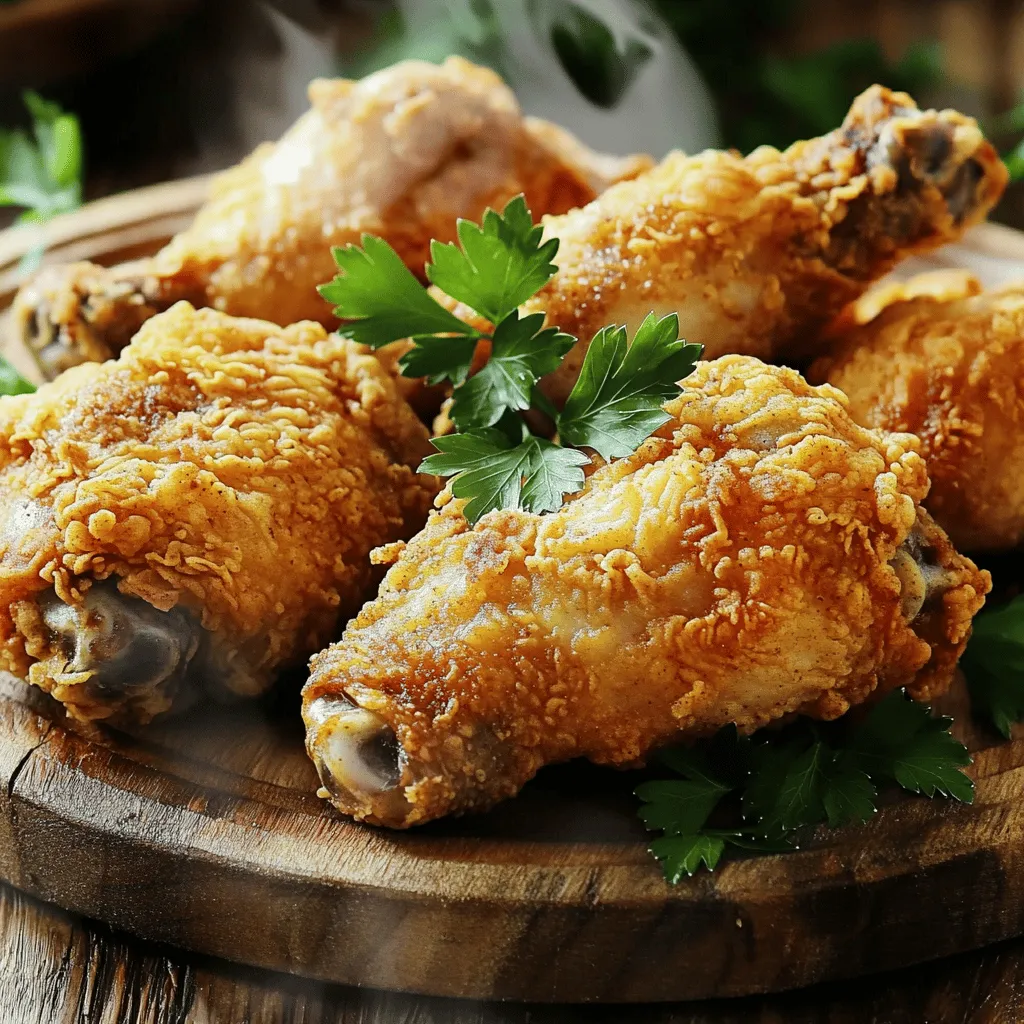Fried chicken is a favorite for many, but what if you’re out of buttermilk? No need to worry! I’ve got the perfect recipe that guarantees crispy, flavorful chicken without it. Using simple alternatives like milk and lemon juice, you can create a mouthwatering dish that’s full of flavor. Follow along as I guide you through easy steps to achieve that golden crust you crave. Ready to fry up some deliciousness? Let’s get started!
Ingredients
Chicken Selection
For the best fried chicken, I prefer bone-in, skin-on thighs and drumsticks. These cuts stay juicy during cooking. They also give you that crispy skin we all love. If you want to try something else, you can use chicken breasts or wings. Just know that they may cook faster, so watch them closely.
Dry Ingredients
Next, let’s talk about the dry mix. You need all-purpose flour and some seasonings. Here are the must-have spices for extra flavor:
– 1 cup all-purpose flour
– 1 teaspoon paprika
– 1 teaspoon garlic powder
– 1 teaspoon onion powder
– 1 teaspoon dried thyme
– 1 teaspoon cayenne pepper (adjust this to your spice level)
– 1 teaspoon salt
– 1 teaspoon black pepper
Feel free to adjust the spice levels to match your taste. You can swap cayenne for chili powder if you want it milder.
Wet Ingredients
For the wet mix, we’ll use milk and lemon juice. This combo works great as a buttermilk alternative. Here’s how you do it:
– 1 cup milk (or a dairy-free alternative)
– 1 tablespoon lemon juice
Mix these two and let them sit for about 5 to 10 minutes. This step helps thicken the milk. If you prefer a completely dairy-free option, try almond or oat milk. They will still give you a nice creamy crust.
For the full recipe, check out the detailed instructions later in this article.
Step-by-Step Instructions
Marinating the Chicken
To start, you’ll need to make a milk and lemon juice mixture. Combine 1 cup of milk with 1 tablespoon of lemon juice in a small bowl. This mix will create a faux buttermilk. Let it sit for about 5 to 10 minutes. This step is key. It helps tenderize the chicken and adds flavor.
Preparing the Breading
Now it’s time to prepare the breading. In a large bowl, mix together 1 cup of all-purpose flour, 1 teaspoon of paprika, 1 teaspoon of garlic powder, 1 teaspoon of onion powder, 1 teaspoon of dried thyme, 1 teaspoon of cayenne pepper, 1 teaspoon of salt, and 1 teaspoon of black pepper. This blend will give your chicken great taste.
For effective coating, take each piece of chicken and dip it into the milk mixture first. Make sure it’s fully coated. Let any extra liquid drip off. Then, dredge the chicken in the seasoned flour mix. Press gently to help the flour stick. Place the coated chicken on a plate.
Frying the Chicken
Next, heat oil in a deep skillet or frying pan. Aim for medium-high heat, about 350°F (175°C). To check if the oil is ready, sprinkle a bit of flour in it. If it sizzles, you’re good to go.
Carefully add the chicken pieces to the hot oil. Avoid overcrowding the pan. Fry the chicken for about 10 to 12 minutes on each side. You want it to be golden brown. To ensure it’s cooked through, check that the internal temperature reaches 165°F (75°C).
Once done, remove the chicken from the oil. Place it on a paper towel-lined plate to drain the excess oil. Let it cool slightly before serving. For the full recipe, refer back to the earlier section.
Tips & Tricks
Achieving a Crispy Texture
The right oil temperature is key to crispy fried chicken. You want your oil hot, around 350°F (175°C). If it’s too cool, the chicken will soak up oil and turn greasy. Too hot, and the outside burns before the inside cooks. Test the oil by dropping a bit of flour in it. If it sizzles, you’re ready to fry.
To keep that crust crispy, avoid overcrowding your pan. Frying too many pieces at once drops the oil temperature. Fry in batches if needed. After frying, place the chicken on a wire rack instead of paper towels. This allows air to circulate and keeps the crust crispy.
Flavor Enhancements
Adding herbs and spices to your breading mix boosts flavor. Try mixing in dried oregano, or thyme for a fresh touch. A bit of cayenne adds heat, but adjust it to your taste. Don’t be afraid to experiment with flavors for a unique twist.
For sides, homemade coleslaw pairs well with fried chicken. Its crunch and creaminess balance the crispy chicken. Try mac and cheese or cornbread for a Southern touch. These sides make the meal feel special.
Safety Tips
Handling raw chicken safely is very important. Always wash your hands before and after touching it. Use separate cutting boards to prevent cross-contamination. Cook chicken to an internal temperature of 165°F (75°C) to ensure it is safe to eat.
Dispose of used oil properly. Let it cool, then pour it into a container. Don’t pour it down the drain. Clean up any spills quickly to avoid slips. Keep your kitchen safe while you fry!

Variations
Different Flavor Profiles
You can spice up your fried chicken in many ways. For a kick, add cayenne pepper or chili powder. If you love garlic, mix garlic powder into your flour. Want something fresh? Try adding herbs like rosemary or thyme. Each of these changes gives your chicken a new twist.
Global takes on fried chicken are also fun. In Korea, they use a sweet and spicy sauce that makes the chicken shine. Jamaican jerk chicken brings a smoky, spicy flavor. You can explore these tastes at home with just a few changes to your recipe.
Cooking Methods
Oven-baked chicken is a great choice for a healthier meal. Coat your chicken in the same seasoned flour. Place it on a wire rack over a baking sheet. Bake at 400°F for about 35-40 minutes. This method gives you crispy skin without deep frying.
If you want a quicker method, try an air fryer. Preheat it to 375°F. Place your coated chicken in the basket in a single layer. Cook for about 25-30 minutes, flipping halfway through. The result is crispy chicken with less oil.
Vegetarian Alternatives
You can still enjoy fried chicken flavors without meat. Use plant-based substitutes like tofu or tempeh. Cut them into pieces and marinate them in the milk and lemon juice mixture.
For the breading, follow the same steps as with chicken. You can also use cauliflower florets for a great veggie option. Dip them in the milk, then coat with the seasoned flour. Fry or bake them just like regular chicken for a tasty treat.
For the full recipe, check out the original instructions to get cooking!
Storage Info
Refrigeration
To keep leftover fried chicken tasty, store it in an airtight container. Place a paper towel at the bottom to absorb moisture. This helps keep the chicken crispy. You can store it in the fridge for up to four days. After that, it may dry out or lose flavor. Always check for any off smells before eating.
Freezing
If you want to save your fried chicken for later, freezing is a great option. First, let the chicken cool completely. Wrap each piece tightly in plastic wrap. Then, place them in a freezer bag. This helps prevent freezer burn. You can freeze fried chicken for up to three months.
To reheat frozen chicken, first thaw it in the fridge overnight. Then, place it in an oven at 400°F (200°C) for about 20-25 minutes. This method keeps the chicken crispy. You can also use an air fryer for about 10-12 minutes at 375°F (190°C) for a quick reheat.
Using Leftovers
Leftover fried chicken is versatile and can be used in many dishes. You can shred it for chicken tacos or toss it in a salad. Another fun idea is to make a fried chicken sandwich. Just add some mayo and pickles on a bun.
For a tasty breakfast, chop it up and mix it into scrambled eggs. You can also use it in soups or stews for added flavor. Check out the Full Recipe for more ideas on how to enjoy your fried chicken.
FAQs
How do you make fried chicken without buttermilk?
To make fried chicken without buttermilk, you can use milk mixed with lemon juice. This creates a similar tangy flavor. Here are the essential steps:
1. Mix Milk and Lemon Juice: Combine 1 cup of milk with 1 tablespoon of lemon juice. Let it sit for about 5-10 minutes. This thickens the milk and gives it that buttermilk feel.
2. Prepare the Coating: In a bowl, mix 1 cup of all-purpose flour with spices like paprika, garlic powder, and cayenne pepper.
3. Coat the Chicken: Dip the chicken in the milk mixture first, then dredge it in the flour mix. This helps the coating stick well.
4. Fry the Chicken: Heat your oil and fry the chicken until it’s golden brown and cooked through. This method results in a crispy and flavorful treat. For the full recipe, check out the Crispy Southern-Style Fried Chicken section.
Can I use yogurt instead of buttermilk?
Yes, you can use yogurt instead of buttermilk. Here are some pros and cons:
– Pros:
– Yogurt offers a similar tangy flavor.
– It can make the chicken very tender.
– Cons:
– Yogurt can be thicker than buttermilk, which may affect the coating.
– You might need to thin it with water or milk to get the right consistency.
What oil is best for frying chicken?
The best oils for frying chicken are vegetable oil and peanut oil. They have high smoke points, making them great for frying. Here are some recommendations:
– Vegetable Oil: This is a common choice due to its neutral flavor and high smoke point.
– Peanut Oil: This oil adds a slight nutty flavor and is great for frying.
Both oils will help you achieve that crispy texture we all love in fried chicken.
How do I know when my fried chicken is done?
To know when your fried chicken is done, check the internal temperature. The chicken should reach 165°F (75°C). Here are some tips for checking doneness safely:
– Use a Meat Thermometer: Insert it into the thickest part of the chicken.
– Look for Color: The chicken should be golden brown and crispy outside.
– Juices Should Run Clear: Cut into the chicken; if the juices run clear, it’s fully cooked.
These tips will help ensure your fried chicken is safe to eat and delicious every time.
In this post, we reviewed how to make delicious fried chicken. We covered selecting chicken cuts, using dry and wet ingredients, and the marinating process. You learned about breading techniques and tips for frying, ensuring crispy and flavorful results. We explored flavor variations, cooking methods, and storage tips.
Fried chicken does not have to be complicated. With your new skills and methods, you can make tasty meals or repurpose leftovers easily. Dive into frying or experimenting with new flavors, and enjoy your culinary journey!

